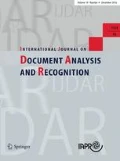Abstract
In spite of the advances in recognition technology, handwritten Hangul recognition (HHR) remains largely unsolved due to the presence of many confusing characters and excessive cursiveness in Hangul handwritings. Even the best existing recognizers do not lead to satisfactory performance for practical applications and have much lower performance than those developed for Chinese or alphanumeric characters. To improve the performance of HHR, here we developed a new type of recognizers based on deep neural networks (DNNs). DNN has recently shown excellent performance in many pattern recognition and machine learning problems, but have not been attempted for HHR. We built our Hangul recognizers based on deep convolutional neural networks and proposed several novel techniques to improve the performance and training speed of the networks. We systematically evaluated the performance of our recognizers on two public Hangul image databases, SERI95a and PE92. Using our framework, we achieved a recognition rate of 95.96 % on SERI95a and 92.92 % on PE92. Compared with the previous best records of 93.71 % on SERI95a and 87.70 % on PE92, our results yielded improvements of 2.25 and 5.22 %, respectively. These improvements lead to error reduction rates of 35.71 % on SERI95a and 42.44 % on PE92, relative to the previous lowest error rates. Such improvement fills a significant portion of the large gap between practical requirement and the actual performance of Hangul recognizers.





Similar content being viewed by others
Notes
SERI95a is also known as KU-1.
References
Park, G.-R., Kim, I.-J., Liu, C.-L.: An evaluation of statistical methods in handwritten Hangul recognition. Int. J. Doc. Anal. Recognit. 16(3), 273–283 (2013)
Kang, K.-W., Kim, J.H.: Utilization of hierarchical, stochastic relationship modeling for Hangul character recognition. IEEE Trans. Pattern Anal. Mach. Intell. 26(9), 1185–1196 (2004)
Bengio, Y.: Learning deep architectures for AI. Found. Trends Mach. Learn. 2(1), 1–127 (2009)
Liu, C.-L., Yin, F., Wang, Q.-F., Wang, D.-H.: ICDAR 2011 Chinese handwriting recognition competition (2011). http://www.nlpr.ia.ac.cn/events/HRcompetition/Report.html
Cireşan, D.C., Meier, U., Schmidhuber, J.: Multi-column deep neural networks for image classification. In: IEEE Conference on Computer Vision and Pattern Recognition (2012)
Cireşan, D.C., Schmidhuber, J.: Multi-column Deep Neural Networks for Offline Handwritten Chinese Character Classification. IDSIA Technical Report No. IDSIA-05-13 (2013)
ImageNet Large Scale Visual Recognition Challenge 2013 (ILSVRC2013) Result. http://www.image-net.org/challenges/LSVRC/2013/results.php
Kim, H.Y., Kim, J.H.: Hierarchical random graph representation of handwritten characters and its application to Hangul recognition. Pattern Recognit. 34(2), 187–201 (2001)
Jang, S.I.: Post-Processing of Handwritten Hangul Recognition Using Pair-Wise Grapheme Discrimination, Master Thesis, KAIST (2002)
Kim, D.-I., Lee, S.-W.: Automatic evaluation of handwriting qualities of handwritten hangul image database, KU-1. In: Proceedings of the 6th IWFHR, pp. 455–464, Taejon, Korea (1998)
Kim, D.H., Hwang, Y.S., Park, S.T., Kim, E.J., Paek, S.H., Bang, S.Y.: Handwritten Korean character image database PE92. In: Proceedings of the 2nd ICDAR, pp. 470–473 (1993)
Bae, H.J., Yun, J.M., Cha, E.Y.: Neural network for hand-written character recognition using dynamic bar method. In: Proceedings of the Korea Information Science Autumn Conference, vol. 17, issue 2, pp. 251–254 (1990)
Kim, M.W., Jang, J.S., Lim, C.D., Song, Y.S., Kim, J.H.: Improvements to a Hierarchical Interaction Neural Network for Context-Dependent Pattern Recognition and Its Experimentation with Handwritten Korean Character Recognition. Technical Report, Electronics and Telecommunication Research Institute, Taejon, Korea (1992)
Jeong, S.H.: Handwritten Hangul Recognition Based on Character Cluster Segmentation, Technical Memo. Electronics and Telecommunication Research Institute, Taejon, Korea (2002)
Torralba, A., Fergus, R., Freeman, W.: 80 million tiny images: a large dataset for non-parametric object and scene recognition. IEEE Trans. Pattern Anal. Mach. Intell. 30(11), 1958–1970 (2008)
Hinton, G.E., Osindero, S., Teh, Y.: A fast learning algorithm for deep belief nets. Neural Comput. 18(7), 1527–1554 (2006)
Hinton, G.E., Dayan, P., Frey, B.J., Neal, R.: The wake-sleep algorithm for self-organizing neural networks. Science 268, 1158–1161 (1995)
Vincent, P., Larochelle, H., Bengio, Y., Manzagol, P.-A.: Extracting and composing robust features with denoising autoencoders. In: Cohen, W.W., McCallum, A., Roweis, S.T. (eds.) Proceedings of the Twenty-Fifth International Conference on Machine Learning (ICML’08), pp. 1096–1103, ACM (2008)
Fukushima, K.: Neocognitron: a self-organizing neural network model for a mechanism of pattern recognition unaffected by shift in position. Biol. Cybern. 36(4), 193–202 (1980)
LeCun, Y., Bottou, L., Bengio, Y., Haffner, P.: Gradient-based learning applied to document recognition. Proc. IEEE 86(11), 2278–2324 (1998)
Simard, D., Steinkraus, P.Y., Platt, J.C.: Best practices for convolutional neural networks. In: Proceedings of the International Conference on Document Analysis and Recognition (ICDAR’03), p. 958. IEEE Computer Society, Washington, DC, USA (2003)
Boureau, Y., Ponce, J., LeCun, Y.: A theoretical analysis of feature pooling in vision algorithms. In: Proceedings of the International Conference on Machine Learning (ICML’10) (2010)
Ozkan, C., Erbek, F.: A comparison of activation functions for multispectral Landsat TM image classification. Photogramm. Eng. Remote Sens. 69(11), 1225–1234 (2003)
Nair, V., Hinton, G.: Rectified linear units improve restricted boltzmann machines. In: Proceedings of the 27th International Conference on Machine Learning (ICML-10) (2010)
Glorot, X., Antoine, B., Bengio, Y.: Deep Sparse Rectifier Networks. In: Proceedings of the 14th International Conference on Artificial Intelligence and Statistics. JMLR W&CP, vol. 15 (2011)
Goodhill, G., Barrow, H.: The role of weight normalization in competitive learning. Neural Comput. 6(2), 255–269 (1994)
Liu, H., Ding, X.: Handwritten character recognition using gradient feature and quadratic classifier with multiple discrimination schemes. In: Proceedings. 8th International Conference on Document Analysis and Recognition, IEEE (2005)
Cireşan, D., et al.: Deep Big Multilayer Perceptrons for Digit Recognition, Neural Networks: Tricks of the Trade, pp. 581--598. Springer, Berlin Heidelberg (2012)
Everitt, B.: The Analysis of Contingency Tables, 2nd edn. Chapman and Hall/CRC, London (1992)
Author information
Authors and Affiliations
Corresponding author
Rights and permissions
About this article
Cite this article
Kim, IJ., Xie, X. Handwritten Hangul recognition using deep convolutional neural networks. IJDAR 18, 1–13 (2015). https://doi.org/10.1007/s10032-014-0229-4
Received:
Revised:
Accepted:
Published:
Issue Date:
DOI: https://doi.org/10.1007/s10032-014-0229-4




